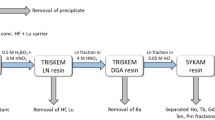Abstract
Iodine-129, with a half life of 15.7Myr (ref. 1), is one of the longest lived of the cosmogenic radionuclides. Although the primordial supply of 129I is now extinct, 129I is continuously being produced in the atmosphere primarily by cosmic ray reactions on xenon2, in the Earth primarily by spontaneous fission of 238U (ref. 3), and in meteorites and the Moon primarily by proton and neutron induced reactions on Te and Ba (ref. 4). The relatively large quantity of 129I introduced into the environment from the nuclear age may be useful as a tracer in groundwater hydrology5. Fissiogenic 129I in large granite formations (batholiths) could be used to establish the suitability of these sites for long term nuclear waste storage, because groundwater movement would carry away the more soluble iodides and disturb the equilibrium 129I/238U ratio. The concentration of 129I in meteorites can be combined with results for shorter-lived radionuclides to provide information on the constancy of the galactic cosmic ray flux over longer time scales than previously possible and also on the preterrestrial history of meteorites. We have applied the new atom counting technique to 129I analysis with a sensitivity (the minimum number of atoms in the sample required to obtain a quantitative result) of less than 107 atoms of 129I in a 1-mg sample. An AgI standard with a known 129I/127I ratio of 10−11 was determined to ±10%, and the background contribution from a reagent grade AgI sample gave an upper limit to the ratio of about 3×10−13. We used a time-of-flight measurement to distinguish 129I from the stable 127I ions that were not separated by the mass analysis system. Our results for the meteorites Bruderheim and Dhajala represent the first direct (that is, not inferred6 from radiogenic Xe) determination of 129I in meteorites. A Xe molecular negative ion was discovered but we show that it is not a problem for 129I analysis.
This is a preview of subscription content, access via your institution
Access options
Subscribe to this journal
Receive 51 print issues and online access
$199.00 per year
only $3.90 per issue
Buy this article
- Purchase on Springer Link
- Instant access to full article PDF
Prices may be subject to local taxes which are calculated during checkout
Similar content being viewed by others
References
Emery, J. F. et al. Nucl. Sci. Engng 48, 319–323 (1972).
Edwards, R. R. & Ray, P. USAEC Rep. NYO-3624-3 (1969).
Purkayastha, B. C. & Martin, G. R. Can. J. Chem. 34, 293–300 (1956).
Kohman, T. P. Carnegie-Mellon Univ. Rep-NYO-844-71, 50–62 (1967).
Edwards, R. R. Science 137, 851–853 (1962).
Podosek, F. A. & Lewis, R. S. Earth planet. Sci. Lett. 15, 101–109 (1972).
Spernol, A. et al. Int. J. appl. Radiat. Isot. 28, 615–624 (1977).
McHugh, J. A. & Sheffield, J. C. Analyt. Chem. 37, 1099–1101 (1965).
Brauer, F. P. Proc. 2nd Conf. Nuclear Methods in Environmental Research CONF-740701, 328–343 (1974).
Rook, H. L., Suddueth, J. E. & Becker, D. A. Analyst. Chem. 47, 1557–1561 (1975).
Elmore, D. et al. Nature 277, 22–25, 246 (1979).
Kilius, L. R. et al. Nature 282, 488–489 (1979).
Hird, B. & Ali, S. P. Can. J. Phys. 57, 867–870 (1979).
Lang, W. & Clerc, H.-G. Nucl. Instrum. Meth. 126, 535–539 (1975).
Kilius, L. R. thesis, Univ. Toronto (1978).
Nishiizumi, K. et al. Earth planet. Sci. Lett. 45, 285–292 (1979).
Author information
Authors and Affiliations
Rights and permissions
About this article
Cite this article
Elmore, D., Gove, H., Ferraro, R. et al. Determination of 129I using tandem accelerator mass spectrometry. Nature 286, 138–140 (1980). https://doi.org/10.1038/286138a0
Received:
Accepted:
Issue Date:
DOI: https://doi.org/10.1038/286138a0
This article is cited by
-
Iodine-129 in ore and surface soil in a uranium deposit
Journal of Radioanalytical and Nuclear Chemistry (2019)
-
Determination of129I in low level radioactive waste by radiochemical instrumental neutron activation analysis
Journal of Radioanalytical and Nuclear Chemistry Articles (1995)
-
Non-conventional measurement techniques for the determination of some long-lived radionuclides produced in nuclear fuel a literature survey
Journal of Radioanalytical and Nuclear Chemistry Articles (1993)
-
Activation analysis of129I
Journal of Radioanalytical and Nuclear Chemistry Articles (1986)
Comments
By submitting a comment you agree to abide by our Terms and Community Guidelines. If you find something abusive or that does not comply with our terms or guidelines please flag it as inappropriate.



